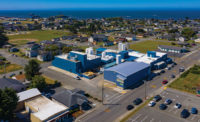Halfway through the family-owned Baker Cheese Inc. plant in St. Cloud, Wis., you’ll come upon a kind of magical lazy river of cheese. Different sizes and varieties of the company’s low-moisture, part-skim mozzarella string cheese float through a stream of brine. The cheeses are headed on the same journey toward the packaging department, where they will be sealed into Baker Cheese-branded or private label packages.
“Each one of the lanes in [the] lazy river is a different product, and they come out separate,” notes Brian Baker, president and CEO.
The organizational feat of this part of the plant has impressed many prospective private label customers, he adds.
Oddly calming to observe, the string cheese river is just one example of how the 104-year-old company manages to stay on top of the over
200 SKUs it produces for its own brand and its many private label customers (see Processor Profile). Despite its limited space, the Baker Cheese plant can produce and package many different product lines at the same time.
The 174,000-square-foot plant processes an immense quantity of milk — 2.35 million pounds — a day. In fact, in the last five years alone, Baker Cheese has produced enough string cheese to make a continuous rope from Earth to the moon, Baker notes. And it plans to grow even more.
Segregated milk lines
The string cheese production at Baker Cheese begins in receiving, where the milk is received from local farms 18 hours a day, seven days a week, says Jeff LeBeau, master cheesemaker for Baker Cheese. It takes about 50 minutes to unload a tanker and send it on its way.
From there, the milk goes into one of two pasteurizers. Each pasteurizer corresponds with one milk line, and each line has its own set of vats and tables, Baker says. This allows the company to produce both conventional and organic products at the same time. (The company also has segregated brine systems.)
“So we have two lines [of] specific segregated milk that comes up into the plant,” says Baker. “Because in essence, we kind of have two production plants out there, and they all integrate into one packaging operation.”
The second milk line was part of a plant expansion that was finalized just this past August; it’s located in a separate section in the plant. At the time of Dairy Foods’ visit, Baker Cheese was producing its branded string cheese on the old line and organic string cheese on behalf of a private label customer on the new line.
After the milk is pasteurized, it travels to the vats, Baker notes. The original milk line feeds five vats (with room for three more), and the new line feeds three vats (with room for three more). In the vats, the milk forms into cheese curds, which are pumped onto finishing tables to be salted. Samples are pulled from the table to be tested for pH level and moisture in an in-house lab.
At this point, the curds are almost ready to be extruded into string cheese; they are blown from the table through a hose into either the mixer/cooker (if Baker Cheese is making plain string cheese) or the dry-batch mixer/cooker (if a flavor such as jalapeño is being added). It takes about 10 minutes for the curds to become string cheese, Baker says.
After leaving the cooker, the cheese is pulled through the diffuser head of one of nine extruders. This forms it into ropes, which are then cut into individual string cheeses by an automatic cutter at the end of the extruder, Baker explains. The cutter can be adjusted to produce different-sized cheeses.
“The shortest we can cut is ¾ inch,” adds Baker. “We’re looking to get even shorter with [research and development].”
Now, the cheeses are ready for their journey in the lazy river brine, notes LeBeau. They float through the brine for 10 minutes before heading to the packaging department.
Integrated packaging
The two sides of Baker Cheese’s plant become one in the packaging department, which has 180 employees — 75% of the company’s workforce. To keep the packaging department running efficiently, one team of eight people is assigned to each line, says Barb Schneider, packaging manager. Each team has a team leader, who dons a light blue hair net. Supervisors wear dark blue ones.
This manpower is needed, as the packaging area is the busiest part of the Baker Cheese plant. It’s not uncommon for the plant to package 190,000 sticks in an hour, Baker says, and the department needs to stay highly organized, as it often is packaging many different SKUs at the same time.
“[The cheese] goes to one of 10 lines, depending on what type of cheese product we’re making, whether it’s organic or conventional,” explains Schneider. “These lines are segregated by different-colored tubs, depending on where they’re going.”
The packaging area features both automatic and manual cheese organizers. The employees working the automatic loaders keep their eyes out for any missing string cheeses and load those by hand, Baker explains. The sticks go through machines to be vacuum-sealed while they are fresh.
“It comes out of the other end of the machine, and there’s employees there doing quality checks on the pieces to make sure the package is sealed tight, code dates are accurate, packaging is accurate,” notes Schneider. “And then sometimes a secondary wrap is put onto the already sealed product if that’s what the customer wants.”
The now-wrapped sticks go through a metal detector. Then they are put into case boxes and palletized. The finished boxes are stored in Baker Cheese’s on-site finished goods cooler, where they are shipped out within 48-72 hours, says Jim Guell, plant facilities manager.
Smart updates
Baker Cheese’s most recent expansion is the sixth the company has embarked on since 1985. Back in 1985, the plant was “busting at the seams,” Baker notes, so Baker Cheese added new manufacturing, pasteurization and separator and culture areas to increase its cheese production and packaging capabilities.
The next three expansions, in 1999, 2003 and 2010, brought the plant up to 93,006 square feet and added packaging equipment, larger vats, new milk silos, automated cheesemaking systems and more. A 2017 project added new employee services, a new shipping and receiving dock, dry storage and a finished goods cooler.
While each plant update came with room to expand, Baker Cheese’s exponential growth means the company keeps needing more space. Its production has grown 500% in the past 20 years, Baker says. Baker Cheese is one of only a handful of companies in the United States that produces string cheese
“[There] was a 20-year plan in the early 2000s. Within 10 years, we had filled that completely and had to do another expansion in 2010,” he adds. “That was about a 15-year plan with that expansion. And pretty much by 2017 or 2018, we already had filled that, hence the expansion that we just moved into a couple months ago.”
Part of the idea with the 2019 update was to enhance Baker Cheese’s opportunities to produce organic string cheese, while not taking away from its conventional capacity. This is why the company wanted to add an entirely new line with a segregated milk source, Baker explains. The 2019 update also included new packaging equipment, boilers, whey rooms and brine tanks.
The company had been capacity-constrained by its plant size, which means it previously had to turn away prospective clients. Baker says he hopes that the 2019 plant extension will allow Baker Cheese to say yes to more new customers and grow within the existing space.
“The [2019] plant addition was the single largest capital expenditure that the company has ever undertaken,” he notes. “But we also built it to have a footprint for growth by adding equipment as necessary. So as we continue to grow, we can relatively easily just pick and place pieces of equipment into that plant floor.”
In addition to financing expansions, Baker Cheese has invested in updating and adding software systems to help it manage the heavy workload in the plant. In the packaging area, this includes a system that helps the company to track line efficiencies.
“We put in a new packaging operational software system in the last 18 months to track our throughput much more effectively and more in real-time for our employees on the line, the supervisors, up to the managers, up to the executive team for each of the packaging lines by each of the SKUs that we do,” Baker says.
TVs in the packaging area display data from the tracking system so supervisors can make adjustments in real time. This is essential for the Baker Cheese operation because the pace of the packaging department determines how much cheese should be produced on the other side of the plant, LeBeau says.
“It’s given us a real-time data point that they can communicate back through all departments and production so they can make adjustments to properly feed the packaging room with a proper amount of sticks per hour without affecting any of the quality elements of it,” Baker adds.
Focus on sanitation
The Baker Cheese plant runs 24 hours a day, five days a week. There are two production shifts and one overnight shift, from 6:00 p.m. to 3:30 a.m., in which employees sanitize the plant.
“Basically, we have a shift that comes in and they usually help out with a little bit of production at the end and then they go through all the cleaning procedures, take any equipment apart,” says LeBeau. “They have a post-op inspection and a pre-op inspection. And they do ATP swabs at the end of the night on the equipment. They take different spots, different days.”
According to Baker, the plant has a robust environmental swabbing process. The employees take micro-swabs on a daily basis and send them out to third-party labs to verify the in-house lab tests.
“All the microbe stuff is sent out to Northern Labs, as well as sometimes Cherney Labs,” adds LeBeau.
Baker Cheese also ensures that its plant’s clean-in-place (CIP) processes are effective by working with its sanitation vendors, says Jim Schumacher, manager of quality assurance.
“They come in and they look at the process, they do their testing, they pull samples,” he adds. “They do some microanalysis themselves.”
Waste reduction
Baker Cheese is currently working on the final stages of an updated sustainability program, Baker says, but it already has implemented waste-reduction processes in its plant. For example, the company looked into its packaging processes to figure out how to increase efficiencies. In its most popular packaging line, it chose to get rid of one of its packaging styles in favor of the one that used less plastic.
“So just for that one package line and that one package change … we will reduce the plastic usage by 17%,” Baker says.
Another sustainability effort is reusing water in CIP processes after it goes through reverse osmosis (RO), notes LeBeau.
“The water coming off the RO when we concentrate the solids off the whey, we pull the water out, so we’re reusing a lot of that water for our CIP systems on the rinse side,” he says. “So it saves us a ton of water.”
Baker Cheese also invested in creating its own wastewater plant in 2016, which is located in a separate building on the plant’s campus. Previously, the company had to ship out its wastewater.
“We’d have a tremendous amount of trucks over the road with wastewater taking it to a municipality to treat,” says Baker. “We have our own wastewater treatment facility tied into this plant now. So the amount of over-the-road trucks and water that’s being shipped and used to municipalities was reduced by a factor of about 90%.
“Finding out processes that we can do from a sustainability [standpoint] and reducing waste is a big piece of what we’re always evaluating,” he adds.








